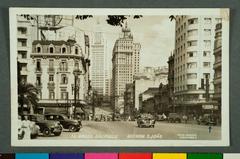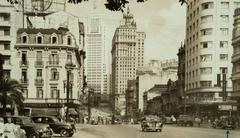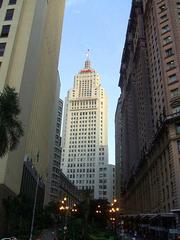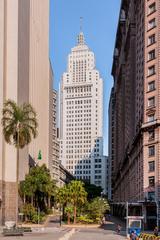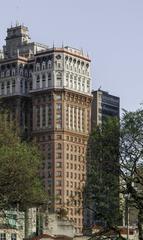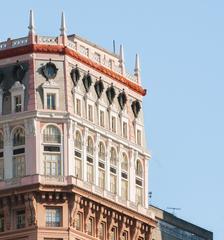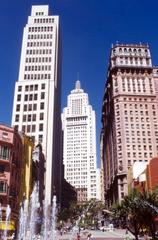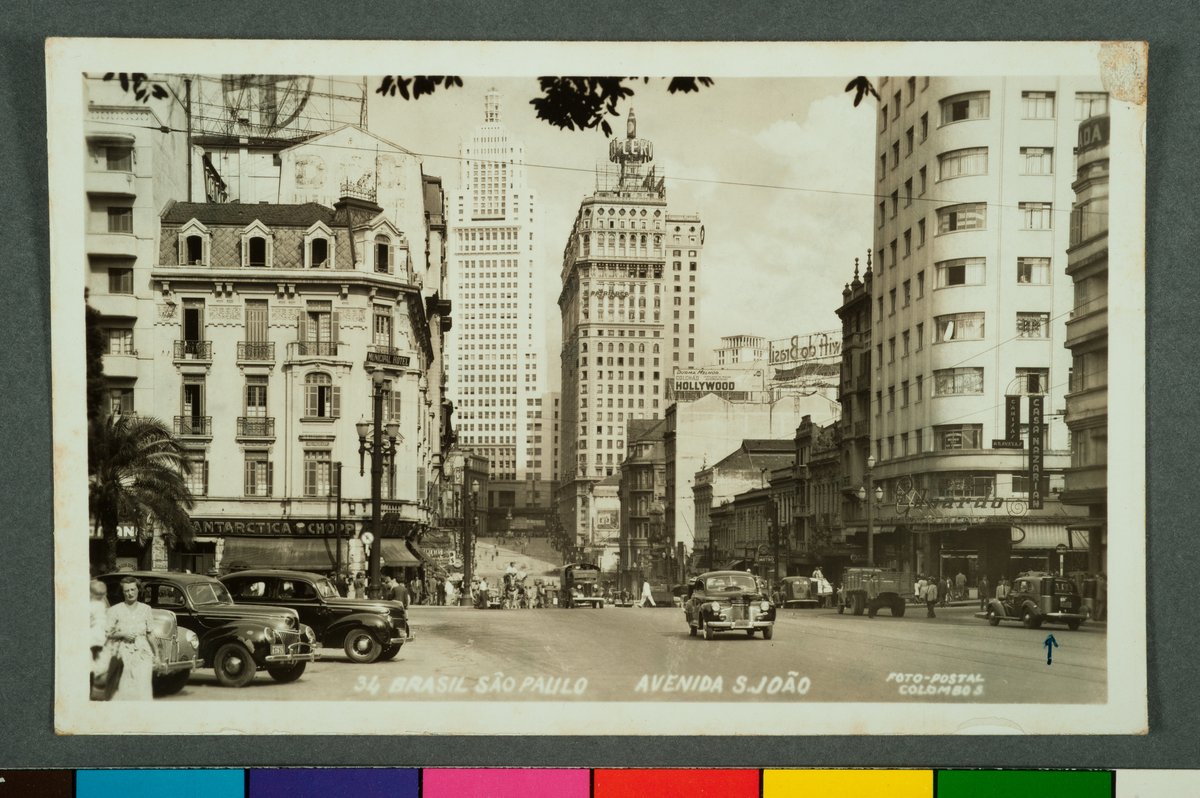
Martinelli Building: Visiting Hours, Tickets, and Historical Significance in São Paulo
Date: 14/06/2025
Introduction
The Martinelli Building (Edifício Martinelli) stands as a monumental symbol of São Paulo’s transformation into a cosmopolitan metropolis. Rising in the heart of the city’s Centro Histórico, this pioneering skyscraper has witnessed and influenced over a century of urban, social, and architectural history. Conceived by Italian entrepreneur Giuseppe Martinelli and completed in 1934, the building’s blend of eclectic and neoclassical styles, innovative engineering, and storied past continues to captivate visitors, historians, and architects. Today, it is celebrated not only for its architectural grandeur but also as a vibrant cultural and municipal hub, offering panoramic rooftop views and dynamic programming.
This comprehensive guide covers the history, architectural significance, visiting hours, ticketing, accessibility, travel tips, and cultural offerings at the Martinelli Building—ensuring you make the most of your visit to this iconic São Paulo landmark. For current details, always consult official sources and tourism platforms. (Prefeitura de São Paulo, ArchDaily, Visit São Paulo)
Historical Overview
Vision and Origins
The Martinelli Building reflects São Paulo’s early 20th-century ambition and economic boom, particularly during the coffee era. Giuseppe Martinelli, an Italian immigrant, envisioned a skyscraper to rival those in North America and Europe. Originally designed as a 12-story building by Hungarian architect William Fillinger, the project expanded—ultimately reaching 30 stories and 130 meters, making it the tallest in Latin America upon completion (ArchDaily, Prefeitura de São Paulo).
Construction and Innovation
Built between 1924 and 1934, the Martinelli Building introduced innovative techniques to Brazil, including steel-reinforced concrete and a foundation of 1,200 wooden piles to support its immense weight (Instituto Moreira Salles). Its ornate, eclectic façade draws inspiration from European palaces, featuring decorative columns, cornices, and pilasters. The building’s verticality defined the city’s skyline and symbolized progress (ArchDaily).
Social and Cultural Impact
Upon opening, the building became a hub for luxury residences, offices, shops, a hotel, and a rooftop observation deck—serving as a social and commercial nucleus (Visit São Paulo). Its presence in literature, cinema, and photography cemented its status as a cultural icon (Instituto Moreira Salles).
Decline and Revitalization
After losing control of the building in 1934 due to financial and political challenges, Martinelli’s vision was put at risk. By the mid-20th century, urban decay led to deterioration and crime (Folha de S.Paulo). In the late 1970s, the city expropriated and restored the Martinelli, designating it a heritage site and repurposing it for municipal and commercial use (Prefeitura de São Paulo).
Continuing Legacy
Today, the Martinelli Building is a model of adaptive reuse. It remains a symbol of São Paulo’s resilience and cosmopolitan identity, hosting municipal offices, cultural spaces, and guided tours that highlight its storied past and architectural achievements (ArchDaily, Visit São Paulo).
Architectural Highlights
Design and Structure
- Eclecticism: The façade merges neoclassical and Beaux-Arts influences with decorative elements and a tripartite structure: foundation, body, and crowning (placestovisitbrazil.com).
- Materials: Imported luxury materials include Norwegian and Swedish pink cement, Italian marble, Belgian mirrors, and Swiss elevators (Predio Martinelli).
- Engineering: Steel-reinforced concrete and deep foundations ensured stability and set new standards for skyscraper construction in Brazil.
- Rooftop: The balustraded terrace and cupola offer 360-degree city views and are a focal point for tours and events.
Urban Influence
The Martinelli Building’s scale and ambition inspired subsequent skyscrapers in São Paulo, such as the Altino Arantes (Banespa) and Itália buildings, promoting vertical urbanism and shaping the city’s development (placestovisitbrazil.com).
Visiting the Martinelli Building: Practical Information
Location and Directions
- Address: Avenida São João, 35, Centro Histórico, São Paulo.
- Public Transport: Nearest metro stations are São Bento and Sé (Blue Line); multiple bus lines serve the area (Atlas Obscura).
- Parking: Limited; public transportation is recommended.
Visiting Hours (as of 2025)
- Standard Hours: Monday to Friday, 9:00 am–5:00 pm.
- Special Hours: Saturdays (9:00 am–1:00 pm) and Sundays for certain events; advance booking required for weekends (Edifício Martinelli).
- Note: Hours may vary due to restoration; always check the official website before visiting (Atlas Obscura).
Ticketing
- General Admission: Entry to rooftop terrace and guided tours may require a ticket, especially during weekends or special events.
- Pricing: Standard tickets are R$20 for adults, with discounts for students, seniors, and children. Some educational and group visits may be free (São Paulo Tourism Official Site).
- Booking: Tickets can be purchased online or at the entrance. Advance booking is highly recommended due to demand and visitor limits (São Paulo Secreto).
Accessibility
- The building is wheelchair accessible, with ramps and elevators installed and further improvements underway to ensure inclusivity (ArchDaily).
- Staff are available to assist visitors with mobility needs.
Guided Tours
- Languages: Primarily in Portuguese, with English and Spanish available upon request.
- Duration: Approximately one hour, featuring historical anecdotes, architectural highlights, and urban legends.
- Booking: Advance reservation is advised, especially for weekends and group visits (Atlas Obscura).
Rooftop and Observatory
- Access: The 25th to 28th floors house the observatory, offering panoramic views and serving as a venue for exhibitions and events (Edifício Martinelli).
- Photography: Allowed throughout the building; professional equipment may require advance permission.
Events and Cultural Programming
- The Martinelli Building hosts year-round cultural events, including art exhibitions, concerts, dance performances, rooftop parties, and centenary celebrations (São Paulo Secreto).
- Recent revitalization projects have introduced new venues for gastronomy, art, and music, making the building a dynamic center for São Paulo’s creative scene.
Urban Legends and Mysteries
- The building’s colorful history has inspired tales of hauntings and unexplained phenomena, often featured in guided tours (ArchDaily).
- It played roles in the 1932 Constitutionalist Revolution and was once a vertical tenement, adding to its mystique (Atlas Obscura).
Practical Tips for Visitors
- Best Times: Weekday mornings are less crowded for a relaxed visit.
- Amenities: Renovations include new cafés, restaurants, retail spaces, and a museum.
- Nearby Attractions: São Paulo Cathedral, Pátio do Colégio, and Theatro Municipal are within walking distance.
- Safety: The building is well-maintained and equipped with modern security systems (Predio Martinelli).
- Booking: Always book tickets and tours in advance, especially during peak periods or special events.
Frequently Asked Questions (FAQ)
Q: What are the Martinelli Building visiting hours?
A: Standard hours are Monday to Friday, 9:00 am–5:00 pm. Some weekends and events may have different times; check the official website.
Q: How much do tickets cost?
A: Standard tickets are R$20, with discounts for students, seniors, and children. Some educational visits are free.
Q: Is the Martinelli Building accessible?
A: Yes, it is equipped with elevators and ramps, with ongoing improvements for full accessibility.
Q: Are guided tours available in English?
A: Yes, English and Spanish tours are available upon request.
Q: Can I take photos inside?
A: Yes, photography is allowed, especially on the rooftop. Professional equipment may require authorization.
Q: What nearby attractions can I visit?
A: São Paulo Cathedral, Pátio do Colégio, and Theatro Municipal are all within walking distance.
Conclusion
The Martinelli Building is more than a skyscraper—it is a living testament to São Paulo’s architectural innovation, cultural diversity, and urban resilience. From its ambitious beginnings and luxury heyday through periods of decline, revitalization, and vibrant renewal, the building invites visitors to explore both the history and the contemporary life of the city. With accessible visiting hours, affordable ticketing, guided tours, and panoramic rooftop vistas, the Martinelli Building remains a must-see destination for anyone exploring São Paulo’s heritage.
Official Sources and References
- Prefeitura de São Paulo
- ArchDaily
- Instituto Moreira Salles
- Folha de S.Paulo
- Visit São Paulo
- Places to Visit Brazil
- São Paulo Tourism Official Site
- Atlas Obscura
- São Paulo Secreto
- Predio Martinelli
- Edifício Martinelli
- ArchDaily: Refurbishing Buildings, Haunted by the Past
